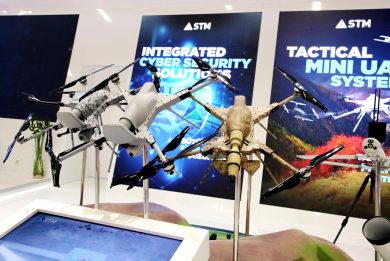FEINDEF 2025 – Arquimea, the Q-SLAM family of loitering munitions grows
As promised at IDEX less than three months ago, at FEINDEF Arquimea is unveiling its new loitering munition, the Q-SLAM-100, which flanks the smaller Q-SLAM-40, present at the Madrid exhibition in a five-canister launcher installed on an 8×8 UGV
With a take-off mass of 12 kg, of which 4 kg are represented by the warhead, the Q-SLAM-100 has the typical architecture of canister-launched loitering munitions. The new weapon is carried in a rectangular container which serves also as launcher, the rear wings hinged on top folding forwards, the front wings hinged on the bottom of the square section fuselage folding rearwards, the vertical fin that opens downwards folding towards the front, the propeller blades folding rearwards. The munition has a winsgpan of 2.24 metres.
At the front we find a gimbal with four windows as it hosts two visible spectrum cameras, one uncooled thermal imager and a laser rangefinder. Behind it comes the warhead, hosted in the front section of the fuselage which is slightly bigger compared to the rest of the aircraft body. The lethal package is of the shaped charge type, which means the Q-SLAM-100 main targets are armoured vehicles or hard targets. Arquimea officials underline that the company is ready to integrate warheads identified by the customer, providing these respect the dimensions and mass limits of the system. The new loitering munition is not however necessarily a suicide system, as it can be also exploited for gathering intelligence thanks to the optronic package as well as for AI algorithms. The munition is fitted with the company DeepArq AI artificial intelligence platform that provides collaborative flight and autonomous decision-making capabilities, situational awareness, object identification and classification, target and threat recognition. It also allows dealing with unknown situation detection giving it the ability to make real-time risk assessments.
The operator can control the warhead status at any time, and he can arm the warhead, disarm it, or detonate it, detonation modes being impact and at will. In the latter case the Q-SLAM-100 can be used to counter a drone threat, the operator commanding the warhead explosion when the loitering munition is in the vicinity of the threat.
Should the mission end without the need to detonate the munition, the airframe can come back in friendly lines and crash landed, once the operator has made sure the warhead fuse is disarmed. The new Arquimea loitering munition is not designed for a quick turnaround before going back in action; at landing the airframe gets damaged, hence it is returned to a logistic area where it can be repaired and send back into action once the repair is completed.
The Q-SLAM-100 is fitted with an electric motor located at the rear of the fuselage that activates a two-blade propeller. Arquimea does not comment on the power source, the only comment we gathered was that “it is not a battery”. This gives an endurance in excess of 2 hours, the range being 60 km.
The munition has a cruise speed of 100 km/h, which increases at over 160 km/h in the final attack phase, and it can sustain winds of 44 km/h. An anti-jam system is fitted, however should the GNSS signal be spoofed the airframe would return close to the launch area. If the contact with the ground control station is lost the Q-SLAM-100 with increase its altitude to try to reconnect, and should this fail it would crash once the power source would go dry. The autopilot was developed by Arquimea, EDR On-Line understanding that notwithstanding the countermeasures the enemy might eventually take control of the munition, but what he will never be able to do is to influence the arm/disarm mechanism.
The current production capacity by Arquimea is of 1,000 Q-SLAM-100 per month, which might obviously considerably increase in a wartime situation.
EDR On-Line understood that more than one new system is under development at the company. The Q-SLAM-200 will be quite different as it will be catapult launched rather that tube-launched, which allows avoiding the wing folding mechanism. Endurance will be increased to over 3 hours, it will carry a 6 kg warhead, and will have a 120 km/h cruise speed and an over 180 km/h in the attack phase.
Simulators will be provided for all Arquimea munitions, the Q-SLAM-40 also being used in the unarmed version to train specialists that will serve in a unit equippedwith such systems.
Photos by P. Valpolini








